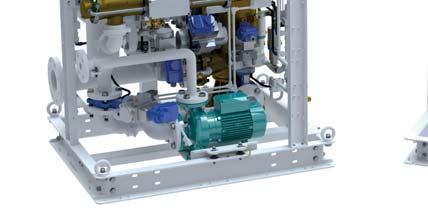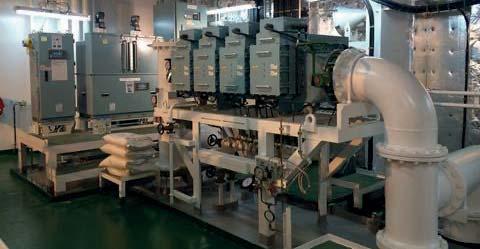
6 minute read
CYBER SECURITY AUDITS NEED TO COVER BWMS: BIO-UV
By BIO-UV Group’s Maritime Division, BIO-SEA Business Director, Maxime Dedeurwaerder
From September 2024, ships with systems that fail to meet IMO and/or US Coast Guard requirements are at risk of detention by Port State Control authorities with serious off-hire implications, berthing delays, charter disruption, and large financial penalties. Yet, some owners have not invested sufficient resources in their ballast water installations. And to be fair, there has been plenty of time to tackle the challenges, of which there are many.
These projects are much more than simple equipment acquisition, though this of course is a fundamental consideration. But equally as important, in my view, is integrating the system within an existing ship. This, together with a vessel’s likely operating profile, should drive decisions on the choice of technology.
As the market has grown in maturity, it has weeded out the technologies of choice. And today, the vast majority of systems operate on the basis of ultra-violet (UV) treatment combined with filtration, such as our BIO-SEA system, or electro-chlorination. There are other technologies, of course, but they tend to be suited for specific vessel and operational requirements.
However, the backdrop is far more complicated than this because even systems based on the same treatment technology vary significantly in terms of efficacy. Waters of high turbidity such as those found off parts of the Chinese coast, for example, are challenging for UV systems. That is why our BIO-SEA system is a carefully designed combination of UV disinfection and filtration.
In our arena, there are two clear groups of UV system manufacturers – one in Europe and one in Asia – whose systems provide different levels of efficiency. Careful analysis of system performance – level of UV dose and holding time, for example – is therefore essential.
At BIO-UV Group, we have our own internal engineering personnel who specialise in the correct dosing levels, for example. So, we don’t have to rely on external engineering or development teams. This means that we can bring to bear knowledge gained from water treatment system installations in other challenging industrial sectors.
Cyber security needs
I want to draw owners and operators attention to the looming requirements of cyber security.
The operating software used by ballast water treatment systems poses a threat to a vessel’s cyber security, as it represents a point of entry for the cyber hacker. If the ballasting system is accessed by criminals there is a significant risk to ship stability, crew safety and the environment. We recommend in the strongest terms that owners ensure that
The differences between systems have important implications for ship operators. One, it is important to pick a ballast water system that can be integrated effectively with a ship’s likely trading pattern. If the vessel is to trade in Asian waters much of the time, robust filtration and UV dosing is an important factor. A second aspect of this point is whether a ship’s operating profile can be adjusted – to enable ballast hauls between two ports where water conditions are challenging, for example.
We have seen a number of owners opting not to install treatment systems because their ships operate consistently in the same region. But in our experience, this is a shortsighted strategy because the absence of an effective system has a significant impact on vessel value and can also be a constraint on vessel deployment.
Furthermore, the cost of retrofit can be significantly less than the reduction in a vessel’s value resulting from not the ballast water treatment system’s control software is sufficiently protected against cyber-attack.



This has a number of implications for BWMS systems. It is important to bear in mind that there are a huge number of systems installed some time ago, well before some of the latest advances in cyber security were made available. Most of these legacy systems are probably not suitable for security upgrades and could be attractive targets for criminals.
8 Annual system checks for BWMS systems are mandatory under US regulations and should form part of a robust maintenance schedule, BIO-UV’s Maxime Dedeurwaerder insists having a ballast water installed. This is because of constraints on future employment possibilities.
As many of you know, the International Association of Classification Societies (IACS) has recently published two unified requirements relating to the cyber resilience of ships and their equipment. And we are following these and making sure that they will be implemented on system installations from 2024. We have recently completed testing new BIO-SEA cyber secure control software for to ensure that our cyber framework offers the right level of security and hope to have full class approval in 2023.
Therefore, we see that having an effective system installation is a significant priority for buyers. This is clearly evident in the offshore market (OSVs and PSVs, in particular) and is likely to underpin a buoyant retrofit market lasting well past September 2024.
It should also provide guidance for those who claim that there is no return on investment for system installations. It is true that having a system does not increase revenue generating capability. But the converse is also true – not having one could result in the loss of a charter contract or a discount in vessel value. In other words, there is a price attached to not having a robust system on board.
Another key aspect which we believe is sometimes overlooked is the need for ship operators to account for ongoing system service and maintenance and, critically, crew training. We are moving from a market in which it was important to have a system installed on board, to one in which it is essential to demonstrate that the system operates effectively and is properly managed by the seagoing staff onboard.
We believe that shipowners should rely on support from system manufacturers in terms of training and annual system checks. Although such checks are not required by the IMO, they are mandatory under US regulations and should definitely be included in a robust maintenance schedule.
We have found, in practice, that seafarers who need to familiarise themselves with certain types of systems can be supported at the same time as the annual check. They may well be familiar with generic systems, but not with the requirements relating to specific installations.
For the record, our BIO-SEA systems are relatively easy to use, and personnel training is straightforward. We use a network of Certified Service Partners around the world to ensure that our clients have access to the best service and support in any location. This approach also safeguards the validity of our OEM original warranty.
We also strongly recommend that ship operators should keep a stock of spare parts on board. Although this is not a class requirement, why would you not keep spares for a ballast water system in the same way as you would for any other critical system on board?
Techcross announces first unified BWMS control
Techcross, the Korean ballast water management system (BWMS) supplier, has announced that it has concluded orders for two new products as part of its diversification strategy. It has recently concluded a contract for a unified control panel for its BWMS system, permitting vessel personnel to monitor and control the company’s BWMS system, as well as its tank level gauge and valve lining systems remotely.

TThe unified control panel, named the Techcross IBTV (or Techcross Integrated BWMS TLGS VRCS), will be installed in a demonstration vessel of a research institute in Korea in July 2023.
Techcross will deliver its first reference of its Internet of Things based Techcross IBTV control panel in July 2023.
The solution will allow all the equipment related to the BWMS to be controlled from a single workstation, reducing operational complexity. Techcross notes that in addition to the LGS (Tank Level Gauging System) and VRCS (Valve Remote Control System), the system can also handle the ballast pump.
Cold ironing and electrolysis
Techcross has also announced that it will deliver its first order of a onshore power system (or Alternative Marine Power, AMP) system in April 2023. Techcross recently established a new business focused on shore power supply in response to tightening environmental regulations worldwide. The company cites port level initiatives in the US and China that have banned the operation of generator sets while a vessel is at berth.
In addition, The Motorship notes that Techcross was awarded a contract in September 2022 to develop core materials, parts, and equipment for water electrolysis. The project, which is being coordinated by Korea’s Ministry of Trade, Industry, and
Energy, comprises 16 consortia and 4 subprojects designed to develop localised water electrolysis technology.
Within the four-year KRW14 billion (USD11.1 million) government-funded project, Techcross is responsible for the “Development of Diaphragm Membranes and Electrodes for Large-area Alkaline Water Electrolysis”. Through this progress, Techcross aims to internalize large-area separators and electrodes, which are core materials for alkaline water electrolysis stacks and intends to reduce production costs and acquire quality competitiveness.










